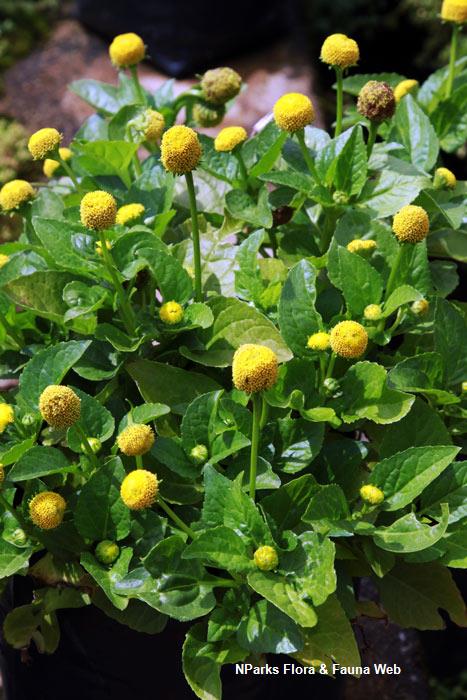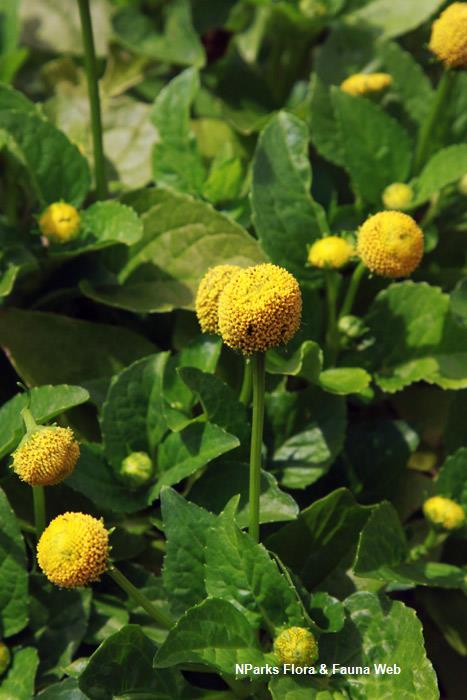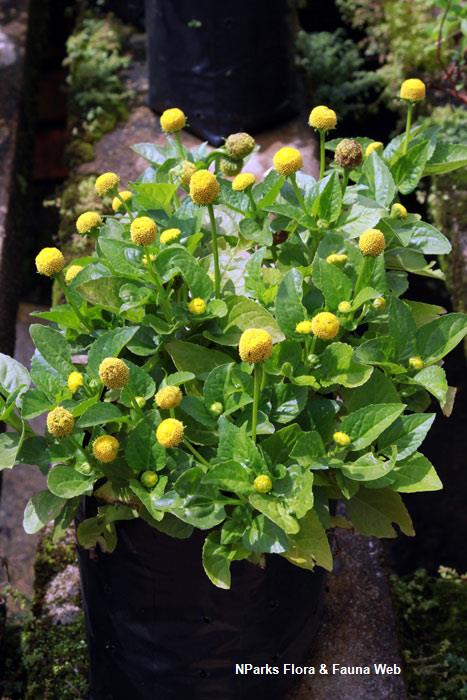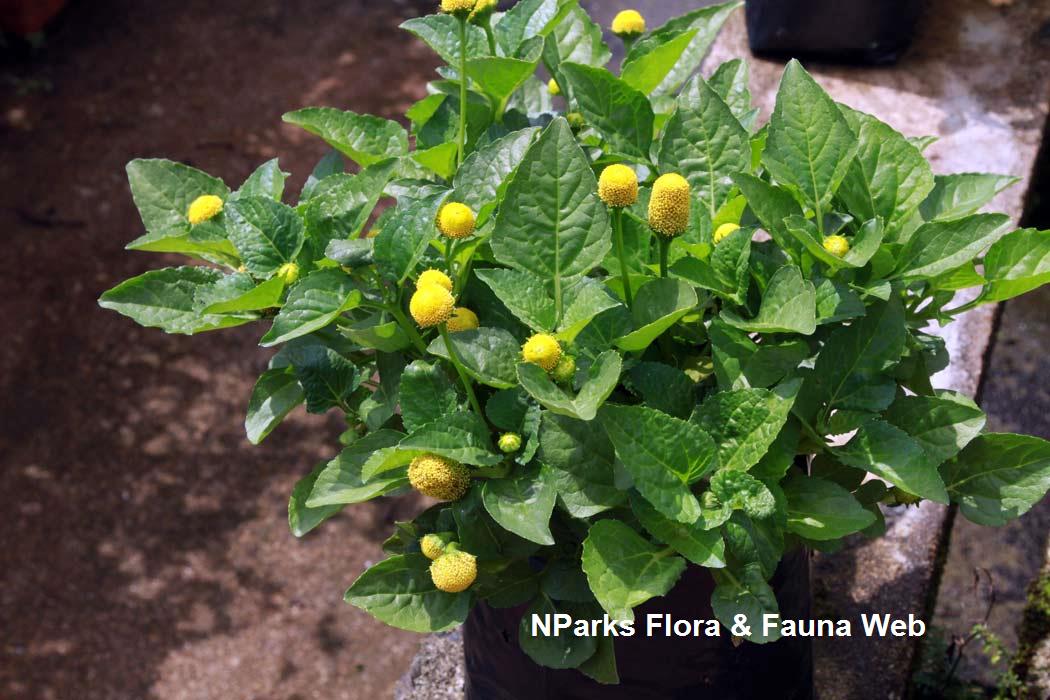
Back
Acmella oleracea (L.) R.K.Jansen
| Family Name: | Asteraceae (Compositae) |
| Synonyms: | Spilanthes oleracea, Spilanthes fusca |
| Common Name: | Toothache Plant, Para Cress, Eyeball Plant, Spilanthes, Paracress, 印度金鈕扣 |
This plant is known as Eyeball Plant, because the yellow to orange, cone-shaped inflorescence sometimes looks like an eyeball when the tip is dark red.
Name
Classifications and Characteristics
| Plant Division | Angiosperms (Flowering Seed Plants) (Dicotyledon) |
|---|---|
| Plant Growth Form | Herbaceous Plant |
| Lifespan (in Singapore) | Perennial |
| Mode of Nutrition | Autotrophic |
| Plant Shape | Compact |
| Maximum Height | 30 cm to 45 cm |
| Maximum Plant Spread / Crown Width | 30 cm to 45 cm |
Biogeography
| Native Habitat | Terrestrial |
|---|---|
| Preferred Climate Zone | Tropical, Sub-Tropical / Monsoonal |
| Local Conservation Status | Non-native (Horticultural / Cultivated Only) |
Description and Ethnobotany
| Growth Form | Perennial herb up to 45 cm tall. |
|---|---|
| Foliage | Leaves are egg-shaped to triangular with a toothed leaf margin (5-11 cm long, 4-8 cm wide). |
| Stems | Prostrate or erect, often reddish, hairless. |
| Flowers | The cone-shaped, yellow to orange inflorescence sometimes has a dark red centre. |
| Fruit | The dry, one-seeded fruit is known as an achene (2-2.5 mm long). |
| Ethnobotanical Uses | Food (Fruit or Vegetable): In India and the Indian Ocean Islands, the leaves are steamed and taken as a vegetable. (Herb or Spice): In Brazil and India, raw leaves are added to salad, soup and meat as a spice. Medicinal: Traditional Medicinal Uses The inflorescence is chewed to temporarily numb the gum, helping to alleviate toothache and gum infection pain. (Caution: A research study found that an extract prepared from the inflorescence was toxic to fish <1>. Always consult your doctor before consuming a plant for medicinal purposes.) It is important to note that some therapeutic effects from traditional medicinal uses of plants are not currently supported or verified by scientific research. |
Landscaping Features
| Landscaping | It is grown as an ornamental (occasionally as a medicinal) in various parts of the world. |
|---|---|
| Desirable Plant Features | Fragrant (Flowers, Foliage), Ornamental Flowers |
| Landscape Uses | Small Gardens, Flowerbed / Border, Groundcover, Container Planting |
Plant Care and Propagation
| Light Preference | Full Sun, Semi-Shade |
|---|---|
| Water Preference | Moderate Water |
| Rootzone Tolerance | Moist Soils, Well-Drained Soils, Poor Infertile Soils, Acidic (low pH) Soils, Alkaline high pH Soils, Easy to Grow |
| Propagation Method | Seed |
Foliar
| Foliage Retention | Evergreen |
|---|---|
| Mature Foliage Colour(s) | Green |
| Foliar Type | Simple / Unifoliate |
| Foliar Arrangement Along Stem | Opposite |
| Foliar Attachment to Stem | Petiolate |
| Foliar Shape(s) | Non-Palm Foliage (Ovate, Deltoid) |
| Foliar Venation | Pinnate / Net |
| Foliar Margin | Dentate |
| Foliar Apex - Tip | Acute, Acuminate |
| Foliar Base | Truncate / Square, Attenuate |
Floral (Angiosperm)
| Flower Colour(s) | Red, Yellow / Golden |
|---|---|
| Flower Grouping | Cluster / Inflorescence |
| Inflorescence Type | Compound Head / Capitulum |
Fruit, Seed and Spore
| Fruit Classification | Simple Fruit |
|---|---|
| Fruit Type | Indehiscent Dry Fruit , Achene |
References
| References | <1> Custodio de Souza, G., Dias Ribeiro da Silva, I., Duarte Viana, M., Costa de Melo, N., Sánchez-Ortiz, B.L., Maia Rebelo de Oliveira, M., Ramos Barbosa, W., Maciel Ferreira, I. & Tavares Carvalho, J.C. (2019). Acute Toxicity of the Hydroethanolic Extract of the Flowers of Acmella oleracea L. in Zebrafish (Danio rerio): Behavioral and Histopathological Studies. Pharmaceuticals (Basel) 12(4): 173-189. |
|---|
Image Repository
Others
| Master ID | 30538 |
|---|---|
| Species ID | 5201 |
| Flora Disclaimer | The information in this website has been compiled from reliable sources, such as reference works on medicinal plants. It is not a substitute for medical advice or treatment and NParks does not purport to provide any medical advice. Readers should always consult his/her physician before using or consuming a plant for medicinal purposes. |











